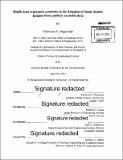Middle East respiratory syndrome in the Kingdom of Saudi Arabia : insights from publicly available data
Author(s)
Majumder, Maimuna S. (Maimuna Shahnaz)
DownloadFull printable version (3.694Mb)
Alternative title
MERS in the Kingdom of Saudi Arabia : insights from publicly available data
Other Contributors
Massachusetts Institute of Technology. Engineering Systems Division.
Advisor
Richard C. Larson.
Terms of use
Metadata
Show full item recordAbstract
Since 2012, more than 1300 cases of Middle East respiratory syndrome (MERS) have been diagnosed worldwide, the vast majority of which have occurred in Saudi Arabia and over 40% of which have ended in death. In Spring 2014, a large outbreak of MERS originated in the Kingdom of Saudi Arabia - concentrated in nosocomial settings in Riyadh and Jeddah - resulting in over 300 infections. We used publicly available data from the Saudi Ministry of Health and World Health Organization to examine the outbreak potential of MERS-Coronavirus and to explore possible risk factors for MERS-related mortality within the context of Saudi Arabia. We also investigated how differential case characteristics between patients reported during the Spring 2014 Saudi MERS outbreak and those reported during non-outbreak periods may provide insight into the propagation of future outbreaks. We found that the Spring 2014 Saudi MERS outbreak was likely due to a super-spreading event, in which a small fraction of cases caused the vast majority of secondary transmissions. Though most cases infected 1 or fewer other individuals, propensity for super-spreading suggests that the outbreak potential of MERS-Coronavirus is significant and that future outbreaks of similar size are expected to occur. Furthermore, we found that early administration of supportive care may be essential to survival once an individual is infected with MERS-Coronavirus; this is especially true for the elderly, who are at increased risk of death. Thus, surveillance - especially among the elderly, who are at increased risk for MERS-related death - is key to reducing fatality. Surveillance is also integral to detecting zoonotic introduction (i.e. host-to-human transmission) events that may trigger future outbreaks if left uncontained. Finally, we found that female and non-comorbid individuals were preferentially infected during the Spring 2014 outbreak, which may lend insight into the enabling conditions that are necessary for MERS outbreaks to emerge and propagate. Further exploration of the mechanisms that result in the zoonotic introduction of MERS-Coronavirus into the human population - as well as the emergence and propagation of MERS outbreaks - is crucial. As demonstrated by the steady stream of sporadic cases that have been reported since the Spring 2014 outbreak, MERS has already gained a firm foothold in the Kingdom of Saudi Arabia. Given that Saudi Arabia is a universal religious travel destination, localized outbreaks may have massive global implications. Because of this, we conclude with the recommendation that the Saudi government should immediately prioritize systematic outbreak planning, preparedness, and prevention. Developing an early warning system (EWS) for MERS in Saudi Arabia using engineering systems modeling methods - namely, system dynamics - may help achieve these ends. If successfully within the context of MERS-Coronavirus in Saudi Arabia, such a modeling framework may also be generalized to other zoonotic pathogens with similar emergent properties and global ramifications.
Description
Thesis: S.M. in Engineering Systems, Massachusetts Institute of Technology, School of Engineering, Institute for Data, Systems, and Society, 2015. "September 2015." Cataloged from PDF version of thesis. Includes bibliographical references (pages 18-22).
Date issued
2015Department
Massachusetts Institute of Technology. Engineering Systems Division; Massachusetts Institute of Technology. Institute for Data, Systems, and SocietyPublisher
Massachusetts Institute of Technology
Keywords
Institute for Data, Systems, and Society., Engineering Systems Division.